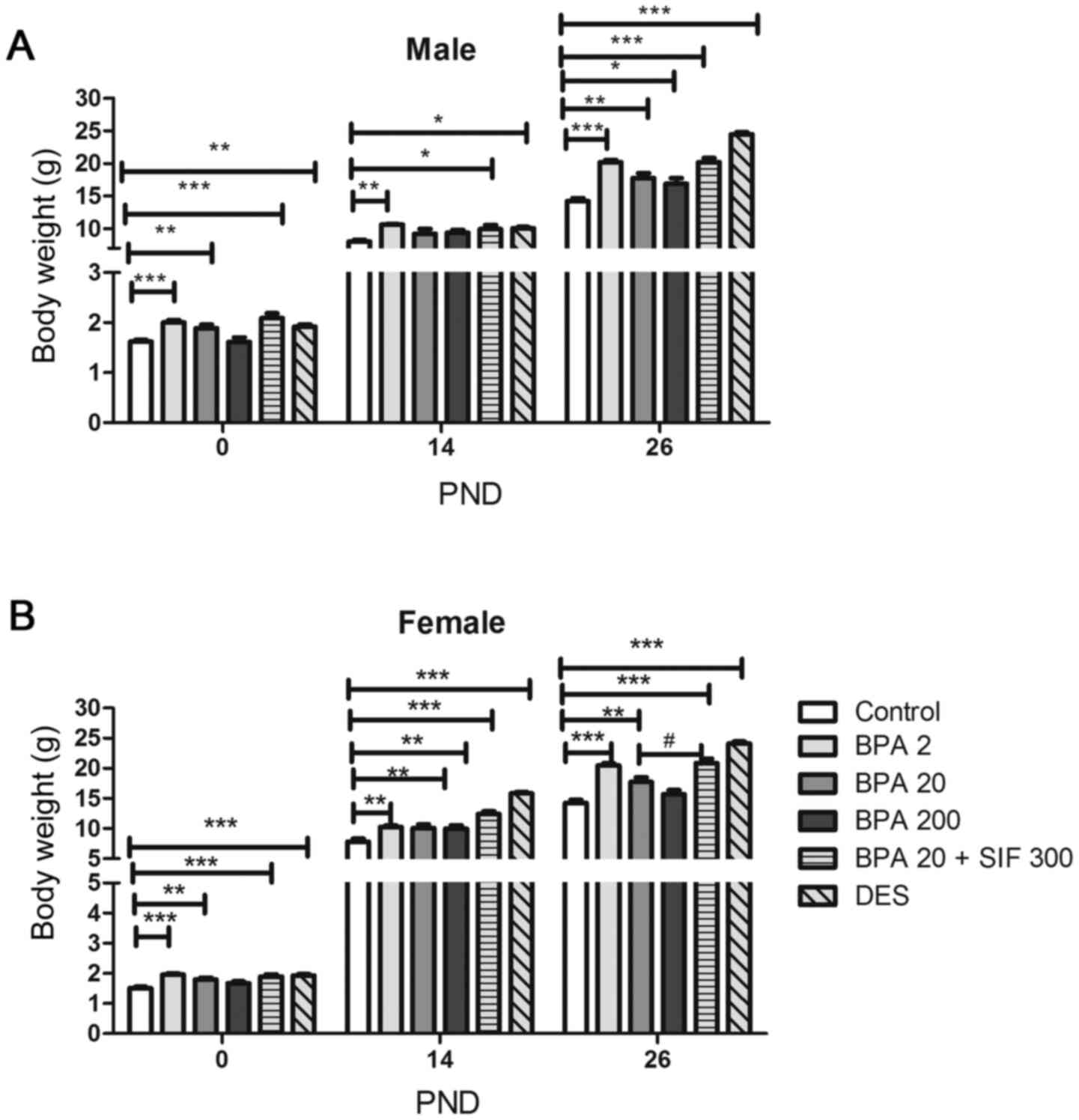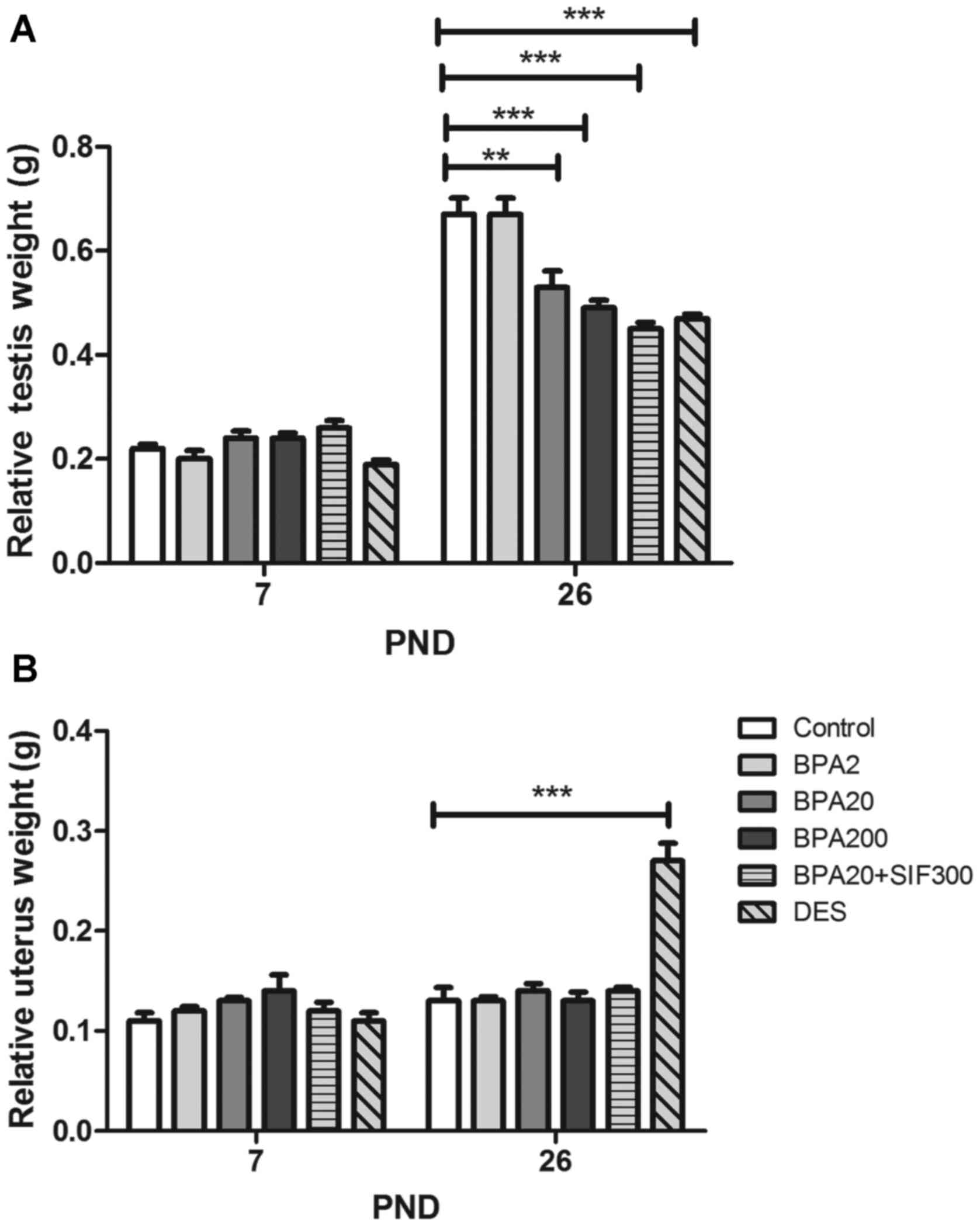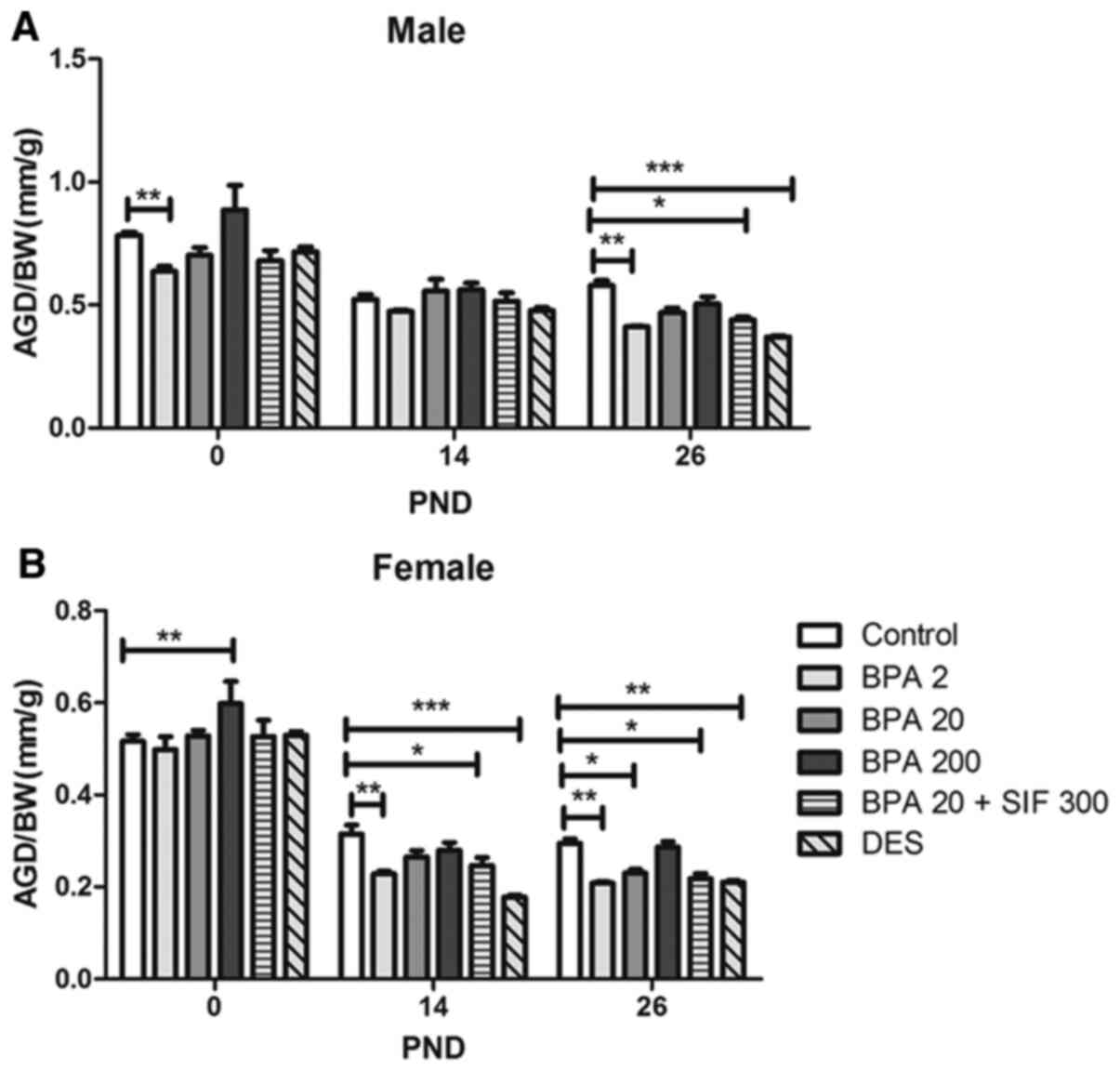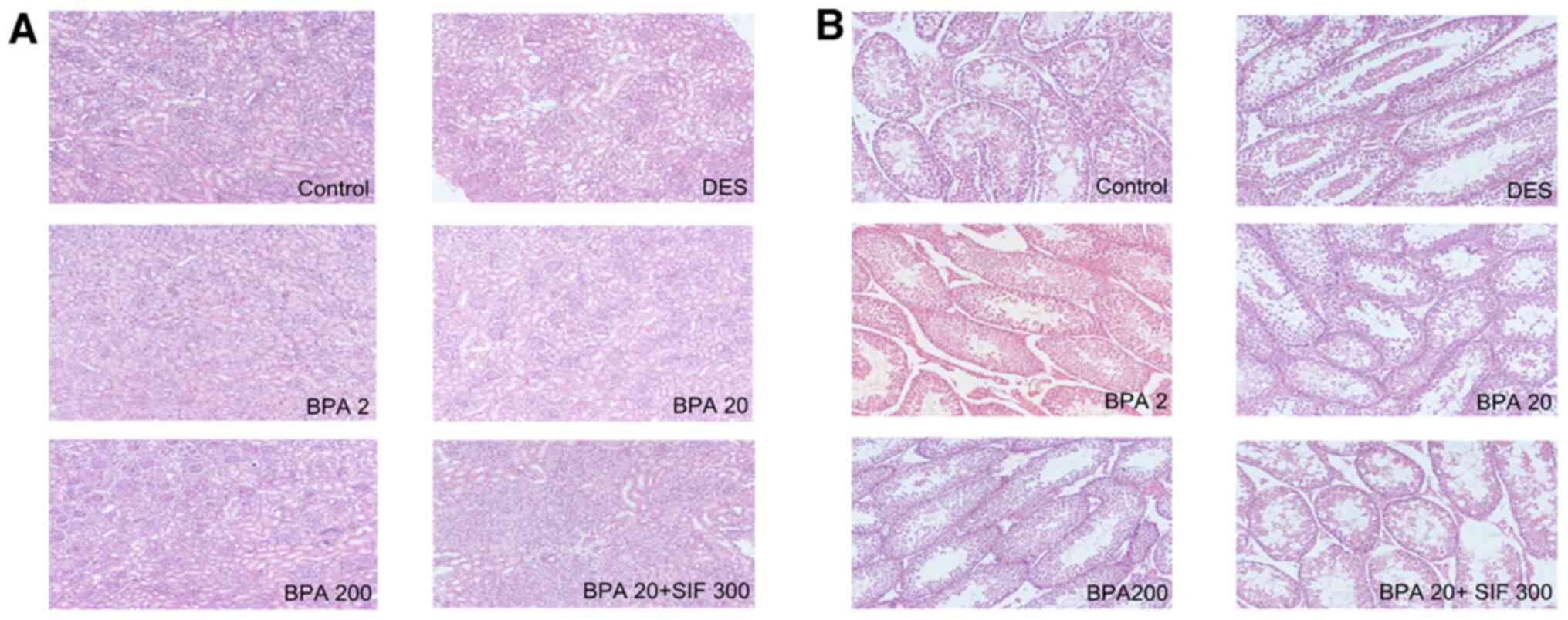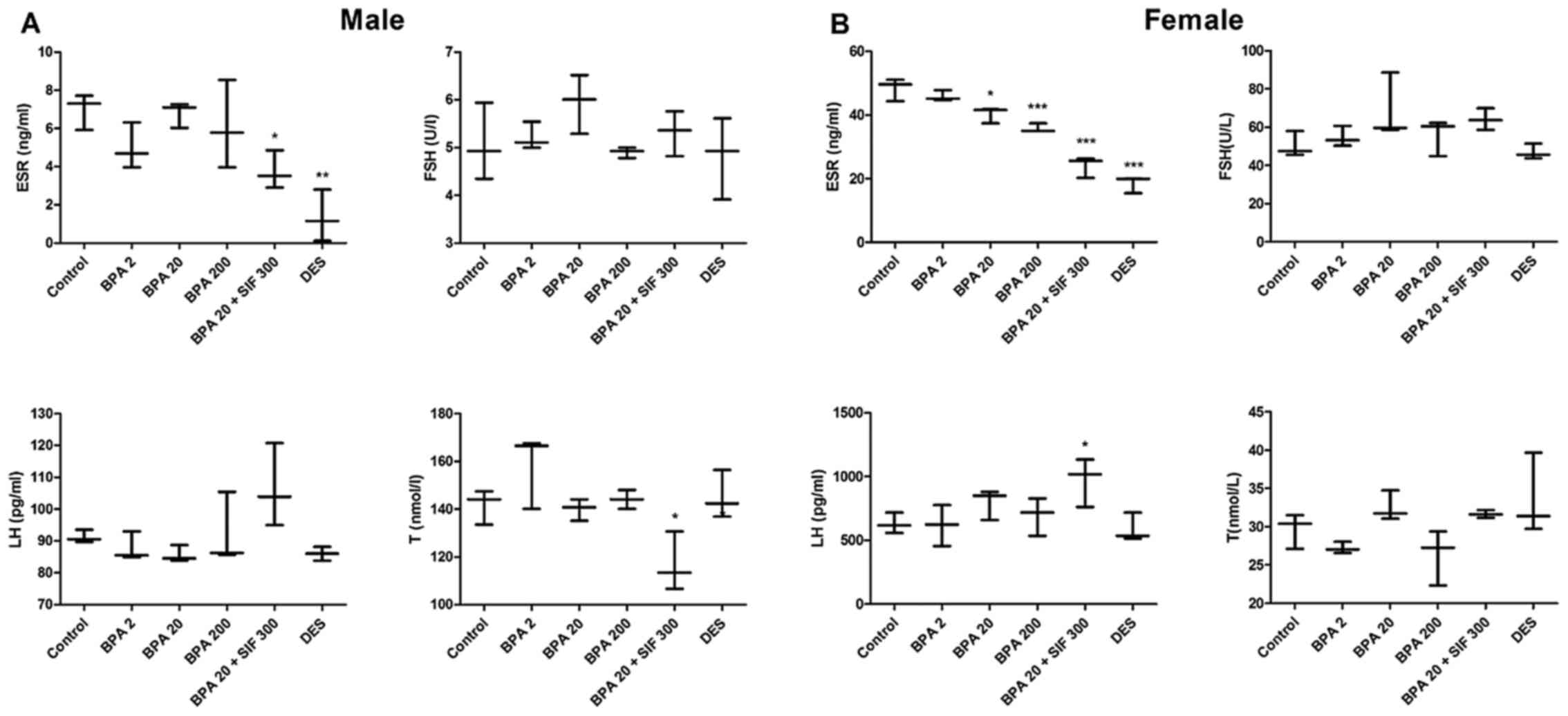|
1
|
vom Saal FS, Akingbemi BT, Belcher SM,
Birnbaum LS, Crain DA, Eriksen M, Farabollini F, Guillette LJ Jr,
Hauser R, Heindel JJ, et al: Chapel Hill bisphenol A expert panel
consensus statement: Integration of mechanisms, effects in animals
and potential to impact human health at current levels of exposure.
Reprod Toxicol. 24:131–138. 2007. View Article : Google Scholar : PubMed/NCBI
|
|
2
|
Mustieles V, Williams PL, Fernandez MF,
Mínguez-Alarcón L, Ford JB, Calafat AM, Hauser R and Messerlian C:
Environment and Reproductive Health (EARTH) St: Maternal and
paternal preconception exposure to bisphenols and size at birth.
Hum Reprod. 33:1528–1537. 2018. View Article : Google Scholar : PubMed/NCBI
|
|
3
|
Vandenberg LN, Hauser R, Marcus M, Olea N
and Welshons WV: Human exposure to bisphenol A (BPA). Reprod
Toxicol. 24:139–177. 2007. View Article : Google Scholar : PubMed/NCBI
|
|
4
|
Chapin RE, Adams J, Boekelheide K, Gray LE
Jr, Hayward SW, Lees PS, McIntyre BS, Portier KM, Schnorr TM,
Selevan SG, et al: NTP-CERHR expert panel report on the
reproductive and developmental toxicity of bisphenol A. Birth
Defects Res B Dev Reprod Toxicol. 83:157–395. 2008. View Article : Google Scholar : PubMed/NCBI
|
|
5
|
Samuelsen M, Olsen C, Holme JA,
Meussen-Elholm E, Bergmann A and Hongslo JK: Estrogen-like
properties of brominated analogs of bisphenol A in the MCF-7 human
breast cancer cell line. Cell Biol Toxicol. 17:139–151. 2001.
View Article : Google Scholar : PubMed/NCBI
|
|
6
|
Rutkowska A and Rachoń D: Bisphenol A
(BPA) and its potential role in the pathogenesis of the polycystic
ovary syndrome (PCOS). Gynecol Endocrinol. 30:260–265. 2014.
View Article : Google Scholar : PubMed/NCBI
|
|
7
|
Barrett ES and Sobolewski M: Polycystic
ovary syndrome: Do endocrine-disrupting chemicals play a role?
Semin Reprod Med. 32:166–176. 2014. View Article : Google Scholar : PubMed/NCBI
|
|
8
|
Faqi AS, Johnson WD, Morrissey RL and
McCormick DL: Reproductive toxicity assessment of chronic dietary
exposure to soy isoflavones in male rats. Reprod Toxicol.
18:605–611. 2004. View Article : Google Scholar : PubMed/NCBI
|
|
9
|
Li L, Zhang X, Zhang W and Song Y: Effects
of lactational exposure to soy isoflavones on steroid receptor
expression in neonate rat ovaries. Wei Sheng Yan Jiu. 36:564–567.
2007.(In Chinese). PubMed/NCBI
|
|
10
|
Guan L, Huang Y and Chen ZY: Developmental
and reproductive toxicity of soybean isoflavones to immature SD
rats. Biomed Environ Sci. 21:197–204. 2008. View Article : Google Scholar : PubMed/NCBI
|
|
11
|
Veiga-Lopez A, Beckett EM, Abi Salloum B,
Ye W and Padmanabhan V: Developmental programming: Prenatal BPA
treatment disrupts timing of LH surge and ovarian follicular wave
dynamics in adult sheep. Toxicol Appl Pharmacol. 279:119–128. 2014.
View Article : Google Scholar : PubMed/NCBI
|
|
12
|
Yu B, Chen QF, Liu ZP, Xu HF, Zhang XP,
Xiang Q, Zhang WZ, Cui WM, Zhang X and Li N: Estrogen receptor α
and β expressions in hypothalamus-pituitary-ovary axis in rats
exposed lactationally to soy isoflavones and bisphenol A. Biomed
Environ Sci. 23:357–362. 2010. View Article : Google Scholar : PubMed/NCBI
|
|
13
|
Ogo FM, de Lion Siervo GEM,
Staurengo-Ferrari L, de Oliveira Mendes L, Luchetta NR, Vieira HR,
Fattori V, Verri WA Jr, Scarano WR and Fernandes GSA: Bisphenol A
exposure impairs epididymal development during the peripubertal
period of rats: Inflammatory profile and tissue Changes. Basic Clin
Pharmacol Toxicol. 122:262–270. 2018. View Article : Google Scholar : PubMed/NCBI
|
|
14
|
Savastano S, Tarantino G, D'Esposito V,
Passaretti F, Cabaro S, Liotti A, Liguoro D, Perruolo G, Ariemma F,
Finelli C, et al: Bisphenol-A plasma levels are related to
inflammatory markers, visceral obesity and insulin-resistance: A
cross-sectional study on adult male population. J Transl Med.
13:1692015. View Article : Google Scholar : PubMed/NCBI
|
|
15
|
Tiwari D and Vanage G: Bisphenol A induces
oxidative stress in bone marrow cells, lymphocytes, and
reproductive organs of holtzman rats. Int J Toxicol. 36:142–152.
2017. View Article : Google Scholar : PubMed/NCBI
|
|
16
|
D'Cruz SC, Jubendradass R and Mathur PP:
Bisphenol A induces oxidative stress and decreases levels of
insulin receptor substrate 2 and glucose transporter 8 in rat
testis. Reprod Sci. 19:163–172. 2012. View Article : Google Scholar : PubMed/NCBI
|
|
17
|
Abarikwu SO, Adesiyan AC, Oyeloja TO,
Oyeyemi MO and Farombi EO: Changes in sperm characteristics and
induction of oxidative stress in the testis and epididymis of
experimental rats by a herbicide, atrazine. Arch Environ Contam
Toxicol. 58:874–882. 2010. View Article : Google Scholar : PubMed/NCBI
|
|
18
|
Saradha B and Mathur PP: Effect of
environmental contaminants on male reproduction. Environ Toxicol
Pharmacol. 21:34–41. 2006. View Article : Google Scholar : PubMed/NCBI
|
|
19
|
Mathur PP and D'Cruz SC: The effect of
environmental contaminants on testicular function. Asian J Androl.
13:585–591. 2011. View Article : Google Scholar : PubMed/NCBI
|
|
20
|
Ghiasvand T, Goodarzi MT, Shafiee G,
Zamani A, Karimi J, Ghorbani M and Amiri I: Association between
seminal plasma neopterin and oxidative stress in male infertility:
A case-control study. Int J Reprod Biomed (Yazd). 16:93–100. 2018.
View Article : Google Scholar
|
|
21
|
Bisht S, Faiq M, Tolahunase M and Dada R:
Oxidative stress and male infertility. Nat Rev Urol. 14:470–485.
2017. View Article : Google Scholar : PubMed/NCBI
|
|
22
|
Naher ZU, Ali M, Biswas SK, Mollah FH,
Fatima P, Hossain MM and Arslan MI: Effect of oxidative stress in
male infertility. Mymensingh Med J. 22:136–142. 2013.PubMed/NCBI
|
|
23
|
Wang W, Hafner KS and Flaws JA: In utero
bisphenol A exposure disrupts germ cell nest breakdown and reduces
fertility with age in the mouse. Toxicol Appl Pharmacol.
276:157–164. 2014. View Article : Google Scholar : PubMed/NCBI
|
|
24
|
Ziv-Gal A, Wang W, Zhou C and Flaws JA:
The effects of in utero bisphenol A exposure on reproductive
capacity in several generations of mice. Toxicol Appl Pharmacol.
284:354–362. 2015. View Article : Google Scholar : PubMed/NCBI
|
|
25
|
Livak KJ and Schmittgen TD: Analysis of
relative gene expression data using real-time quantitative PCR and
the 2(-Delta Delta C(T)) method. Methods. 25:402–408. 2001.
View Article : Google Scholar : PubMed/NCBI
|
|
26
|
Husain K, Dube SN, Sugendran K, Singh R,
Das Gupta S and Somani SM: Effect of topically applied sulphur
mustard on antioxidant enzymes in blood cells and body tissues of
rats. J Appl Toxicol. 16:245–248. 1996. View Article : Google Scholar : PubMed/NCBI
|
|
27
|
López-Armada MJ, Riveiro-Naveira RR,
Vaamonde-García C and Valcárcel-Ares MN: Mitochondrial dysfunction
and the inflammatory response. Mitochondrion. 13:106–118. 2013.
View Article : Google Scholar : PubMed/NCBI
|
|
28
|
Nikolova G, Karamalakova Y and Gadjeva V:
Reducing oxidative toxicity of L-dopa in combination with two
different antioxidants: An essential oil isolated from Rosa
damascena mill., and vitamin C. Toxicol Rep. 6:267–271. 2019.
View Article : Google Scholar : PubMed/NCBI
|
|
29
|
Ide T, Tsutsui H, Hayashidani S, Kang D,
Suematsu N, Nakamura K, Utsumi H, Hamasaki N and Takeshita A:
Mitochondrial DNA damage and dysfunction associated with oxidative
stress in failing hearts after myocardial infarction. Circ Res.
88:529–535. 2001. View Article : Google Scholar : PubMed/NCBI
|
|
30
|
Matés JM: Effects of antioxidant enzymes
in the molecular control of reactive oxygen species toxicology.
Toxicology. 153:83–104. 2000. View Article : Google Scholar : PubMed/NCBI
|
|
31
|
Cao J, Echelberger R, Liu M, Sluzas E,
McCaffrey K, Buckley B and Patisaul HB: Soy but not bisphenol A
(BPA) or the phytoestrogen genistin alters developmental weight
gain and food intake in pregnant rats and their offspring. Reprod
Toxicol. 58:282–294. 2015. View Article : Google Scholar : PubMed/NCBI
|
|
32
|
Maqbool F, Mostafalou S, Bahadar H and
Abdollahi M: Review of endocrine disorders associated with
environmental toxicants and possible involved mechanisms. Life Sci.
145:265–273. 2016. View Article : Google Scholar : PubMed/NCBI
|
|
33
|
Abaci A, Demir K, Bober E and Buyukgebiz
A: Endocrine disrupters-with special emphasis on sexual
development. Pediatr Endocrinol Rev. 6:464–475. 2009.PubMed/NCBI
|
|
34
|
Nohynek GJ, Borgert CJ, Dietrich D and
Rozman KK: Endocrine disruption: Fact or urban legend? Toxicol
Lett. 223:295–305. 2013. View Article : Google Scholar : PubMed/NCBI
|
|
35
|
Legler J, Fletcher T, Govarts E, Porta M,
Blumberg B, Heindel JJ and Trasande L: Obesity, diabetes, and
associated costs of exposure to endocrine-disrupting chemicals in
the European Union. J Clin Endocrinol Metab. 100:1278–1288. 2015.
View Article : Google Scholar : PubMed/NCBI
|
|
36
|
Webb E, Moon J, Dyrszka L, Rodriguez B,
Cox C, Patisaul H, Bushkin S and London E: Neurodevelopmental and
neurological effects of chemicals associated with unconventional
oil and natural gas operations and their potential effects on
infants and children. Rev Environ Health. 33:3–29. 2018. View Article : Google Scholar : PubMed/NCBI
|
|
37
|
Rubin BS, Murray MK, Damassa DA, King JC
and Soto AM: Perinatal exposure to low doses of bisphenol A affects
body weight, patterns of estrous cyclicity, and plasma LH levels.
Environ Health Perspect. 109:675–680. 2001. View Article : Google Scholar : PubMed/NCBI
|
|
38
|
Angle BM, Do RP, Ponzi D, Stahlhut RW,
Drury BE, Nagel SC, Welshons WV, Besch-Williford CL, Palanza P,
Parmigiani S, et al: Metabolic disruption in male mice due to fetal
exposure to low but not high doses of bisphenol A (BPA): Evidence
for effects on body weight, food intake, adipocytes, leptin,
adiponectin, insulin and glucose regulation. Reprod Toxicol.
42:256–268. 2013. View Article : Google Scholar : PubMed/NCBI
|
|
39
|
Hao M, Ding L, Xuan L, Wang T, Li M, Zhao
Z, Lu J, Xu Y, Chen Y, Wang W, et al: Urinary bisphenol A
concentration and the risk of central obesity in Chinese adults: A
prospective study. J Diabetes. 10:442–448. 2018. View Article : Google Scholar : PubMed/NCBI
|
|
40
|
Do MT, Chang VC, Mendez MA and de Groh M:
Urinary bisphenol A and obesity in adults: Results from the
Canadian health measures survey. Health Promot Chronic Dis Prev
Can. 37:403–412. 2017.(In English, French). View Article : Google Scholar : PubMed/NCBI
|
|
41
|
Carwile JL and Michels KB: Urinary
bisphenol A and obesity: NHANES 2003–2006. Environ Res.
111:825–830. 2011. View Article : Google Scholar : PubMed/NCBI
|
|
42
|
Ribeiro E, Ladeira C and Viegas S: EDCs
mixtures: A stealthy hazard for human health? Toxics. 5:52017.
View Article : Google Scholar
|
|
43
|
Wang Q, Ge X, Tian X, Zhang Y, Zhang J and
Zhang P: Soy isoflavone: The multipurpose phytochemical (Review).
Biomed Rep. 1:697–701. 2013. View Article : Google Scholar : PubMed/NCBI
|
|
44
|
Patisaul HB, Sullivan AW, Radford ME,
Walker DM, Adewale HB, Winnik B, Coughlin JL, Buckley B and Gore
AC: Anxiogenic effects of developmental bisphenol A exposure are
associated with gene expression changes in the juvenile rat
amygdala and mitigated by soy. PLoS One. 7:e438902012. View Article : Google Scholar : PubMed/NCBI
|
|
45
|
Muhlhauser A, Susiarjo M, Rubio C,
Griswold J, Gorence G, Hassold T and Hunt PA: Bisphenol A effects
on the growing mouse oocyte are influenced by diet. Biol Reprod.
80:1066–1071. 2009. View Article : Google Scholar : PubMed/NCBI
|
|
46
|
Wade MG, Lee A, McMahon A, Cooke G and
Curran I: The influence of dietary isoflavone on the uterotrophic
response in juvenile rats. Food Chem Toxicol. 41:1517–1525. 2003.
View Article : Google Scholar : PubMed/NCBI
|
|
47
|
Katchy A, Pinto C, Jonsson P, Nguyen-Vu T,
Pandelova M, Riu A, Schramm KW, Samarov D, Gustafsson JÅ, Bondesson
M and Williams C: Coexposure to phytoestrogens and bisphenol a
mimics estrogenic effects in an additive manner. Toxicol Sci.
138:21–35. 2014. View Article : Google Scholar : PubMed/NCBI
|
|
48
|
Couse JF and Korach KS: Estrogen
receptor-alpha mediates the detrimental effects of neonatal
diethylstilbestrol (DES) exposure in the murine reproductive tract.
Toxicology. 205:55–63. 2004. View Article : Google Scholar : PubMed/NCBI
|
|
49
|
Couse JF, Dixon D, Yates M, Moore AB, Ma
L, Maas R and Korach KS: Estrogen receptor-alpha knockout mice
exhibit resistance to the developmental effects of neonatal
diethylstilbestrol exposure on the female reproductive tract. Dev
Biol. 238:224–238. 2001. View Article : Google Scholar : PubMed/NCBI
|
|
50
|
Dupont S, Krust A, Gansmuller A, Dierich
A, Chambon P and Mark M: Effect of single and compound knockouts of
estrogen receptors alpha (ERalpha) and beta (ERbeta) on mouse
reproductive phenotypes. Development. 127:4277–4291.
2000.PubMed/NCBI
|
|
51
|
Newbold R: Cellular and molecular effects
of developmental exposure to diethylstilbestrol: Implications for
other environmental estrogens. Environ Health Perspect. 103 (Suppl
7):S83–S87. 1995. View Article : Google Scholar
|
|
52
|
Aloisi AM, Della Seta D, Ceccarelli I and
Farabollini F: Bisphenol-A differently affects estrogen
receptors-alpha in estrous-cycling and lactating female rats.
Neurosci Lett. 310:49–52. 2001. View Article : Google Scholar : PubMed/NCBI
|
|
53
|
Matthews JB, Twomey K and Zacharewski TR:
In vitro and in vivo interactions of bisphenol A and its
metabolite, bisphenol A glucuronide, with estrogen receptors alpha
and beta. Chem Res Toxicol. 14:149–157. 2001. View Article : Google Scholar : PubMed/NCBI
|
|
54
|
Setchell KD: Soy isoflavones-benefits and
risks from nature's selective estrogen receptor modulators (SERMs).
J Am Coll Nutr. 20 (Suppl 5):S354–S383. 2001. View Article : Google Scholar
|
|
55
|
Setchell KD: Phytoestrogens: The
biochemistry, physiology, and implications for human health of soy
isoflavones. Am J Clin Nutr. 68 (Suppl 6):S1333–S1346. 1998.
View Article : Google Scholar
|
|
56
|
Arisha AH and Moustafa A: Potential
inhibitory effect of swimming exercise on the Kisspeptin-GnRH
signaling pathway in male rats. Theriogenology. 133:87–96. 2019.
View Article : Google Scholar : PubMed/NCBI
|
|
57
|
Huirne JA and Lambalk CB:
Gonadotropin-releas-ing-hormone-receptor antagonists. Lancet.
358:1793–1803. 2001. View Article : Google Scholar : PubMed/NCBI
|
|
58
|
Sikka SC: Relative impact of oxidative
stress on male reproductive function. Curr Med Chem. 8:851–862.
2001. View Article : Google Scholar : PubMed/NCBI
|
|
59
|
Agarwal A, Gupta S and Sharma RK: Role of
oxidative stress in female reproduction. Reprod Biol Endocrinol.
3:282005. View Article : Google Scholar : PubMed/NCBI
|
|
60
|
Armstrong JS, Rajasekaran M, Chamulitrat
W, Gatti P, Hellstrom WJ and Sikka SC: Characterization of reactive
oxygen species induced effects on human spermatozoa movement and
energy metabolism. Free Radic Biol Med. 26:869–880. 1999.
View Article : Google Scholar : PubMed/NCBI
|
|
61
|
Aitken RJ, Buckingham D, West K, Wu FC,
Zikopoulos K and Richardson DW: Differential contribution of
leucocytes and spermatozoa to the generation of reactive oxygen
species in the ejaculates of oligozoospermic patients and fertile
donors. J Reprod Fertil. 94:451–462. 1992. View Article : Google Scholar : PubMed/NCBI
|
|
62
|
Nissanka N and Moraes CT: Mitochondrial
DNA damage and reactive oxygen species in neurodegenerative
disease. FEBS Lett. 592:728–742. 2018. View Article : Google Scholar : PubMed/NCBI
|
|
63
|
Santos TA, El Shourbagy S and St John JC:
Mitochondrial content reflects oocyte variability and fertilization
outcome. Fertil Steril. 85:584–591. 2006. View Article : Google Scholar : PubMed/NCBI
|
|
64
|
Agarwal A and Prabakaran SA: Mechanism,
measurement, and prevention of oxidative stress in male
reproductive physiology. Indian J Exp Biol. 43:963–974.
2005.PubMed/NCBI
|















